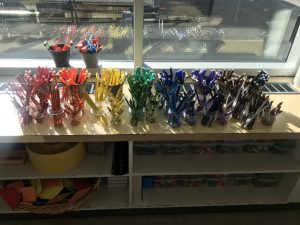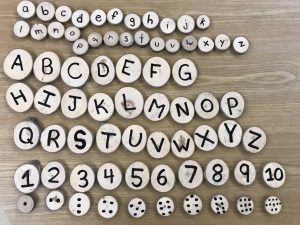Good Evening,
Happy Sunday! With the weekend coming to an end and Monday looming in the near future, I have taken some time to reflect on my teaching practices. This year I sent home a Welcome Letter with my students on the first day of school which outlined a bit of who I am and my perspective in regards to teaching. The following is an excerpt from the letter:
I view children as capable, competent beings who deserve room to explore and grow through real life experiences. Therefore, my teaching practices are deeply rooted in child-centred, inquiry-based, play-based, and place-based experiential learning–pedagogies that have been practiced throughout history by indigenous peoples.
The learning environment plays a large role in early childhood education which is why our classroom is filled with neutral colours, natural materials, and soft lighting. It is my hope to engage the students through providing them with exciting provocations to spark their interest and creativity.
 I very much strive to align my teaching practices with the Reggio Emilia philosophy and I believe this is evident in the ways in which the learning environment has been set up. I always associate the Reggio Emilia philosophy with loose parts and natural materials so I was surprised to come across the work of Galloway (2015), which examined the Reggio Emilia approach in relation to technology and the Maker Movement. As indicated by Galloway (2015) both approaches fit very nicely with the BC Redesigned Curriculum‘s “vision of a personalized and constructivist learning environment” (p. 1); however, I also see parallels with the standards of inquiry within my IB PYP context. While Galloway (2015) focused on a hybrid model of both the Reggio Emilia approach and the Maker Movement with older students (Grade 3), I see value in this model for early learners. Of course the tools presented to Kindergarten students would be different than those offered to older students; however, the premise would be the same–social, knowledge construction through play. In future weeks, I would like to look into which types of materials and technologies early childhood educators present to their young learners that are developmentally appropriate while still eliciting a sense of wonder and honouring the students’ funds of knowledge (Moll & Greenberg, 1990).
I very much strive to align my teaching practices with the Reggio Emilia philosophy and I believe this is evident in the ways in which the learning environment has been set up. I always associate the Reggio Emilia philosophy with loose parts and natural materials so I was surprised to come across the work of Galloway (2015), which examined the Reggio Emilia approach in relation to technology and the Maker Movement. As indicated by Galloway (2015) both approaches fit very nicely with the BC Redesigned Curriculum‘s “vision of a personalized and constructivist learning environment” (p. 1); however, I also see parallels with the standards of inquiry within my IB PYP context. While Galloway (2015) focused on a hybrid model of both the Reggio Emilia approach and the Maker Movement with older students (Grade 3), I see value in this model for early learners. Of course the tools presented to Kindergarten students would be different than those offered to older students; however, the premise would be the same–social, knowledge construction through play. In future weeks, I would like to look into which types of materials and technologies early childhood educators present to their young learners that are developmentally appropriate while still eliciting a sense of wonder and honouring the students’ funds of knowledge (Moll & Greenberg, 1990).
Twenty-first century learners are digital natives who have grown up immersed in technology and, more than ever, they are globally aware, creative and innovative as they take on a new role in this knowledge age.
Galloway, 2015, p. 28
Through reading Galloway’s (2015) MEd project, it became evident that one of the  most prominent ways in which technology was present in both the Reggio Emilia approach and the Maker Movement was through documentation. Both approaches offer great emphasis on making thinking and learning visible. In Kindergarten, learning typically emerges through play which provides a challenge to teachers who are looking for evidence of learning for assessment and reporting. Ideally, I would want regular access to a class set of iPads which my students could use to take pictures, videos, and/or voice recordings of their work to document their own learning. A few years ago in my school district all Kindergarten teachers were given a class iPad for this very reason. It is my hope to advocate for my young learners by requesting an iPad for the classroom that they could use to make the invisible, visible.
most prominent ways in which technology was present in both the Reggio Emilia approach and the Maker Movement was through documentation. Both approaches offer great emphasis on making thinking and learning visible. In Kindergarten, learning typically emerges through play which provides a challenge to teachers who are looking for evidence of learning for assessment and reporting. Ideally, I would want regular access to a class set of iPads which my students could use to take pictures, videos, and/or voice recordings of their work to document their own learning. A few years ago in my school district all Kindergarten teachers were given a class iPad for this very reason. It is my hope to advocate for my young learners by requesting an iPad for the classroom that they could use to make the invisible, visible.
References
Galloway, A. (2015). Bringing a reggio emilia inspired approach into higher grades to 21st century learning skills and the maker movement (Unpublished master’s project). University of Victoria, Victoria, BC
Moll, L. C., & Greenberg, J. B. (1990). Creating zones of possibilities: combining social contexts for instruction. In L. C. Moll (Ed.), Vygotsky and education: Instructional implications and applications of sociohistorical psychology (pp. 319-348). Cambridge: Cambridge University Press
